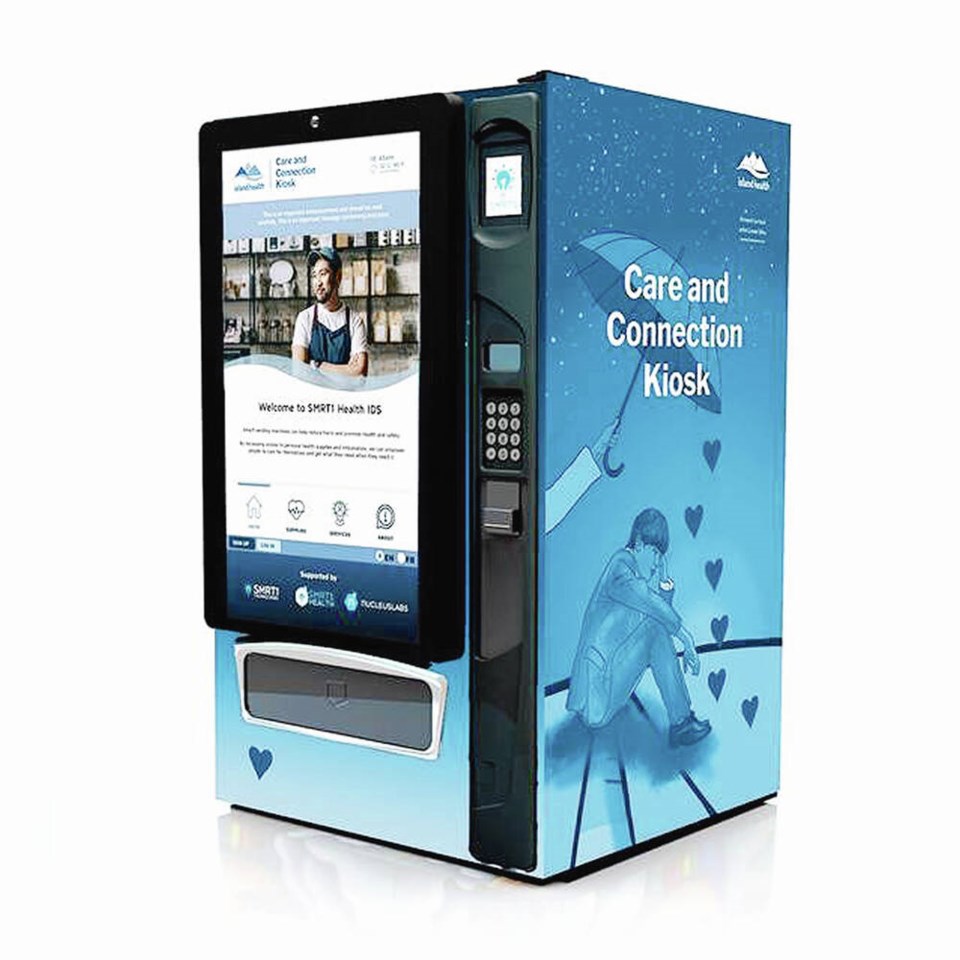Vending machines dispensing condoms, syringes, drug-testing strips, wound-care supplies, naloxone kits and more will be installed outside three Vancouver Island hospital emergency rooms this month.
Island Health is putting the Care and Connection kiosks outside the emergency rooms of Victoria General Hospital, North Island Hospital in Campbell River, and Nanaimo Regional General Hospital. Victoria General’s will be installed on Friday.
The vending machines, funded by the Mental Health and Addictions Ministry, cost $2,000 a month to lease and are stocked by the B.C. Centre for Disease Control.
The health authority said the vending machines will provide around-the-clock free access to harm-reduction supplies and information that’s commonly requested by people who visit hospital ERs.
Island Health medical health officer Dr. Charmaine Enns, in an interview Wednesday, said the touch-screen-operated kiosks don’t require money and act as an extension of the ER.
The kiosks will provide wound-care and sexual health supplies that people “have a right to access” but cannot get because of where they live or work or because of issues with access to services or emergency rooms.
The vending machines are new to Island Health, but have been used successfully in other Canadian and U.S. cities including Vancouver, said Enns.
“The intention is to provide unrestricted access and availability to supplies people are already accessing or should have access to, to keep them well and healthy,” said Enns. “There are no drugs or medications in these machines” apart from naloxone.
Naloxone is only of use to reverse opioid poisoning, she said. She said people emptying the machines is not an issue, based the experience at other sites. “We don’t feel we can put enough naloxone out there.”
Unregulated toxic drugs are the leading cause of death in British Columbia for persons aged 10 to 59, accounting for more deaths than homicides, suicides, accidents and natural diseases combined, said B.C. chief coroner Lisa Lapointe.
The lives of at least 12,929 British Columbians have been lost to unregulated drugs since a public-health emergency was first declared in April 2016.
Greater Victoria, Vancouver and Surrey are the areas experiencing the highest number of unregulated-drug deaths in 2023. By the end of August, 304 people in the Island Health region had died from toxic, unregulated substances.
“We all need to do whatever we can do in all our different roles and capacities to reduce the harm and the likelihood of really tragic outcomes to such a significant proportion of our population,” said Enns. “I’m really hopeful the kiosks are another way to continue to erode the stigma of substance use and so many other challenges people are experiencing in their lives.”
While harm reduction supplies might be ample in downtown Victoria, Enns said it’s males using drugs alone at home who are most often dying from toxic-drug poisonings. Of those who died in 2023, 70 per cent were age 30 to 59, and 78 per cent were male.
The around-the-clock availability of the supplies will make them accessible to more shift workers, people who work during the day, and those wanting to remain anonymous.
“The anonymity that comes with a hospital and hospital grounds is something that is definitely worth trying,” said Enns.
“We will be learning a lot about what supplies people are needing the most and when they are asking for it.”
“We hope it increases people’s access to harm-reduction supplies and information they may have otherwise not have got,” she said.
A new full-time peer support or addiction and recovery worker will ensure each kiosk is well-stocked, maintain proper syringe disposal, and help ensure patients in hospital are able to connect to substance-use supports, Island Health said.
Andy Speck, of ‘Namgis First Nation, who has worked in outreach and struggled with substance use himself, will serve at the North Island Hospital kiosk.
Speck is concerned health officials are missing the biggest target group — people working in trades, primarily men, who he said don’t want to be associated with harm-reduction services because they worry they could be seen and then lose their job.
“Having a kiosk like this is amazing and will absolutely save lives,” Speck said in a statement.
Jennifer Whiteside, minister of mental health and addictions, said shame and blame can keep people who use drugs from asking for help and not accessing the means they need to stay safer. “These new Care and Connection kiosks are discreet and always open, making it easier for more people to get the life-saving supplies and treatment information they need where and when they need it.”
Island Health chief medical health officer Dr. Réka Gustafson said people use alone due to the stigma around their substance use and “sadly, people who use alone in our communities are the most at risk of dying from unregulated substances.”
In addition to harm-reduction supplies, the kiosks will contain information on substance-use treatment, mental health supports, community resources and how people can connect to local services.
Island Health said harm-reduction supply kiosks can reduce overdose rates, decrease new HIV and hepatitis C infections, and distribute more life-saving naloxone and testing strips than in-person services.
>>> To comment on this article, write a letter to the editor: [email protected]



